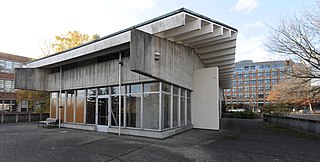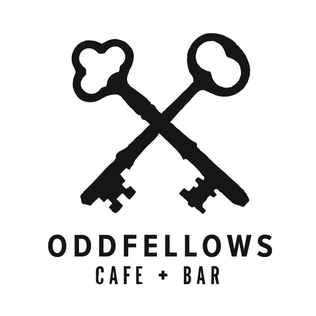
The United States Capitol, often called The Capitol or the Capitol Building, is the seat of the United States Congress, the legislative branch of the federal government. It is located on Capitol Hill at the eastern end of the National Mall in Washington, D.C. Although no longer at the geographic center of the federal district, the Capitol forms the origin point for the street-numbering system of the district as well as its four quadrants.

Capitol Hill is a densely populated residential district in Seattle, Washington, United States. One of the city's most popular nightlife and entertainment districts, it is home to a historic gay village and vibrant counterculture community.

Downtown is the central business district of Seattle, Washington. It is fairly compact compared with other city centers on the U.S. West Coast due to its geographical situation, being hemmed in on the north and east by hills, on the west by Elliott Bay, and on the south by reclaimed land that was once tidal flats. It is bounded on the north by Denny Way, beyond which are Lower Queen Anne, Seattle Center, and South Lake Union; on the east by Interstate 5, beyond which is Capitol Hill to the northeast and Central District to the east; on the south by S Dearborn Street, beyond which is Sodo; and on the west by Elliott Bay, a part of Puget Sound.

The Ward House is a house on Capitol Hill in Seattle, Washington, USA. Having been built in 1882, it is one of the oldest houses in Seattle. Existing houses reportedly built before 1882 in Seattle include the 2629 East Aloha Street (1881), 727 28th Avenue (1870) and Maynard's House located at 3045 64th Avenue Southwest.

Ernest Raymond Steele was an American football running back in the National Football League (NFL) for the Philadelphia Eagles, and the "Steagles", a team that resulted in the temporary merger of the Eagles and Pittsburgh Steelers in 1943. A graduate of Highline High School in Burien, Washington, he played college football at the University of Washington and was drafted in the tenth round of the 1942 NFL Draft by the Pittsburgh Steelers.

Seattle is a seaport city on the West Coast of the United States. It is the seat of King County, Washington. With a 2022 population of 749,256 it is the most populous city in both the state of Washington and the Pacific Northwest region of North America. The Seattle metropolitan area's population is 4.02 million, making it the 15th-largest in the United States. Its growth rate of 21.1% between 2010 and 2020 made it one of the country's fastest-growing large cities.

The Marysville Opera House, located in Marysville, Washington, is a performance hall and meetinghouse constructed in 1911. It was added to the National Register of Historic Places in 1982. It seats approximately 400 people.

Capitol Hill station is a light rail station in the Capitol Hill neighborhood of Seattle, Washington, United States. The station is served by Sound Transit's Link light rail system and is located near the intersection of Broadway and East John Street. It is situated between the Westlake and University of Washington stations on the 1 Line. The station consists of an island platform approximately 65 feet (20 m) under street level, connected to three surface entrances via two mezzanines. It contains pieces of public art, including Mike Ross's sculpture Jet Kiss and two murals by cartoonist Ellen Forney.

The Seattle Streetcar is a system of two modern streetcar lines operating in the city of Seattle, Washington. The South Lake Union line opened first in 2007 and was followed by the First Hill line in 2016. The two lines are unconnected, but share similar characteristics: frequent service, station amenities, and vehicles. Streetcars typically arrive every 10–15 minutes most of the day, except late at night. The streetcar lines are owned by the Seattle Department of Transportation and operated by King County Metro. The system carried 1,093,500 passengers in 2022.

Washington Hall is a historic building and a registered city landmark in Seattle, Washington, that is listed on the National Register of Historic Places. It was originally built as a community center by the Danish Brotherhood in America, a fraternal organization, with meeting halls and one-room apartments for new immigrants. In 1973, the building was sold to the Sons of Haiti who leased the space to various tenants. It was purchased in 2009 by Historic Seattle and was renovated and re-opened in 2010 as an events and performance space.

The University Link tunnel is a 3.15-mile (5.07 km) light rail tunnel in Seattle, Washington. The twin-bore tunnel carries Link light rail service on the University Link Extension of Central Link, running from the Downtown Seattle Transit Tunnel to University of Washington station via Capitol Hill station. The 21 ft-wide (6.4 m) tunnels are lined with precast gasketed concrete segments connected with steel bolts and was excavated using three tunnel-boring machines in 2011 and 2012. Light rail service began on March 19, 2016.

The architecture of Seattle, Washington, the largest city in the Pacific Northwest region of the U.S., features elements that predate the arrival of the area's first settlers of European ancestry in the mid-19th century, and has reflected and influenced numerous architectural styles over time. As of the early 21st century, a major construction boom continues to redefine the city's downtown area as well as neighborhoods such as Capitol Hill, Ballard and, perhaps most dramatically, South Lake Union.

The More Hall Annex, formerly the Nuclear Reactor Building, was a building on the campus of the University of Washington (UW) in Seattle, Washington, United States, that once housed a functional nuclear research reactor. It was inaugurated in 1961 and shut down in 1988, operating at a peak of 100 kilowatts thermal (kWt), and was officially decommissioned in 2007.

The Barnes Building, originally known as the Odd Fellows' Block, the Masonic Temple from 1909 to 1915, and later Ingram Hall, is a historic fraternal and office building located at 2320-2322 1st Avenue in the Belltown neighborhood of Seattle, Washington. Designed in early 1889 and constructed in late 1890 by Seattle Lodge No. 7 of the International Order of Odd Fellows and designed for use by all of the city's Odd Fellow lodges, it is the earliest known surviving work of Seattle architect William E. Boone and George Meeker and remains in an almost perfect state of preservation. The Barnes building has played an important role in the Belltown Community and Seattle's dance community. It was used by the Odd Fellows for 17 years before their departure to a newer, bigger hall in 1909 and was home to a variety of fraternal & secret societies throughout the early 20th century, with the Free and Accepted Masons being the primary tenant until their own Hall was built in 1915. The ground floor has been a host to a variety of tenants since 1890 ranging from furniture sales to dry goods to farm implement sales and sleeping bag manufacturing, most recently being home to several bars. It was added to the National Register of Historic Places as The Barnes Building on February 24, 1975.
Denny Way is an east–west arterial street in downtown Seattle, Washington, United States. It forms the northern end of the Belltown street grid as well as the boundaries of Belltown, Lower Queen Anne, South Lake Union, Denny Triangle, and Cascade. The street continues east through Capitol Hill to Madrona as a minor neighborhood street, ending near Madrona Park on Lake Washington.

Broadway High School, originally known as Seattle High School, opened in Seattle, Washington in 1902 and was the first dedicated high school built in Seattle.

The Capitol Hill Autonomous Zone (CHAZ) or Capitol Hill Organized Protest (CHOP), originally Free Capitol Hill and occasionally the Capitol Hill Occupied Protest (CHOP), was an unlawful occupation protest and self-declared autonomous zone in the Capitol Hill neighborhood of Seattle, Washington. The zone, originally covering two intersections at the corners of Cal Anderson Park and the roads leading up to them, was established on June 8, 2020, by George Floyd protesters after the Seattle Police Department (SPD) left its East Precinct building. The zone was cleared of occupants by police on July 1. Its formation was preceded by a week of tense interactions between protesters and police in riot gear which began on June 1 and escalated on June 7 after a man drove his vehicle toward a crowd near 11th Avenue and Pine Street and shot a protester who tried to stop him. Tear gas, flashbangs and pepper spray were used by police in the densely populated residential neighborhood. On June 7, the SPD reported that the crowd was throwing rocks, bottles, and fireworks, and were shining green lasers into officers' eyes. The next day, the SPD boarded up its building and moved out of the East Precinct in an effort to de-escalate the situation.

Oddfellows Cafe and Bar is a restaurant in Seattle's Capitol Hill neighborhood, in the United States.

Paseo is a chain of Caribbean sandwich shops based in Seattle, Washington, United States. It was founded in 1994 and went bankrupt in 2014 before being revived under new ownership the following year. The restaurant has four locations in King County.



















